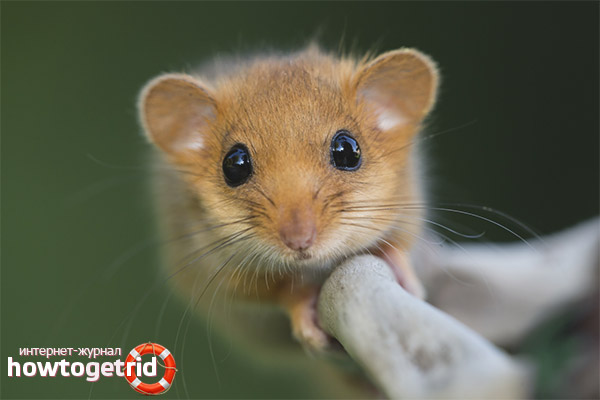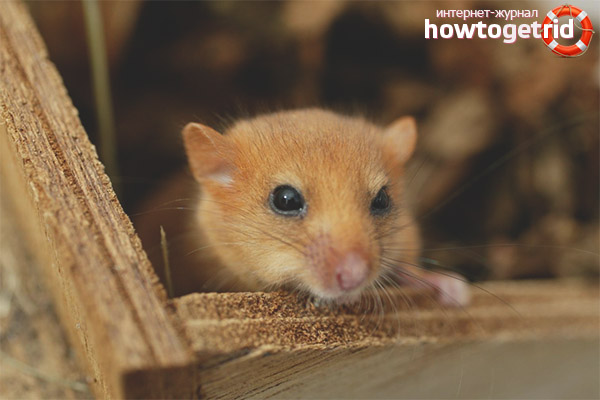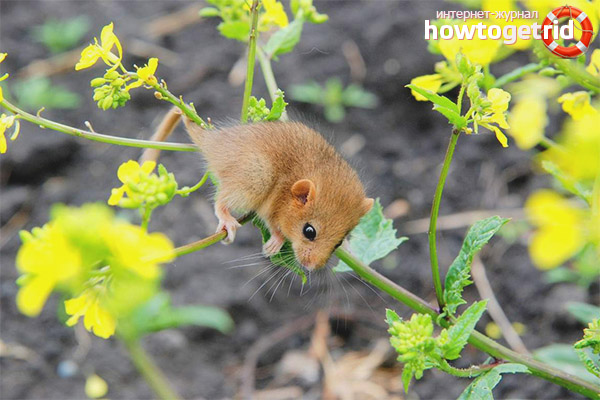The content of the article
Hazel dormouse means a pretty cute beast, similar at the same time to a hamster, squirrel and red mouse. Otherwise, this representative of the family is called a mouslovka. The creature is listed in the Red Book and is protected by law. In today's article, we will consider everything that affects a cute representative of the Sonev family.
Description
- It should be clarified right away that the animal in question is not considered to be either a mouse or a protein, even despite similar external characteristics. The Sonev family includes animals of various dimensions, including the smallest representative. A tiny creature weighs no more than 30 grams, moreover, we are talking about an adult. In size, sony are similar to small mice. This weight characteristic is inherent in individuals who only go into hibernation. After awakening, sleepyheads weigh even less, about 15 grams.
- The body extends up to 9 cm in maximum length. The tail is not included in these indicators, it is given an additional 6 cm. The fur of the animal is soft, colored red on the back. The head and tail are pigmented in the same tone. White or yellow color is observed on the legs and lower section of the abdominal cavity. The end of the tail is white or brown. The animal may have a spotted pattern, which is most distinguished on the brisket and abdomen.
- A distinctive feature of Sony is that the skeleton has the ability to stretch or contract in an upright position. Thanks to this, the animal easily folds into a ball, crawls into small holes, does not take up much space in its home. Paws are elongated, flexible, fingers are strong and tenacious, painted light. There are five fingers on them, four of which are looking forward, and the last is at an angle to the side. An interesting feature is the fact that while jumping from branch to branch, Sony’s hands turn over and practically form a right angle.
- The head is roundish, the nose is pigmented with a pinkish color. Around the nose there are elongated antennae of the vibrissa, they make up more than half the length of the body. These animals can move their small ears alternately. They are rounded, flattened, reminiscent of locators. Eyes bulge a little, have a round format and a decent size. They are painted black, shine. The teeth are sharp, they can easily pierce the nutshell. But sony almost never use incisors during vinegar.
Lifestyle
- Representatives of the family got their name due to the fact that they sleep most of their life. They show activity exclusively at night, creating a lot of noise. Sony sleep in the winter, from October to April. They create minks underground and climb into them. It turns out that more than ½ of life these individuals spend on sleep.
- It is interesting that during hibernation the animal can easily be picked up. The rodent will not wake up. Individuals like the low temperature. When the cold comes, they can sleep for 3 days or more without waking up.
- It has already been mentioned that wakefulness falls at night. These animals come out of their houses and begin to search for food. They crawl and jump on twigs, shrubs, resting on strong paws. Skillfully jump from one place to another, not making the branches heavier.
- Sleepyheads are peace-loving creatures, distinguished by their credulity. They are easily amenable to training, quickly get used to the person, therefore they are kept in an apartment or private house along with hamsters. These animals are considered very popular in the UK. They get along well with children.However, a person is scared that a rodent leads a nocturnal lifestyle, not everyone will like the rustlings during sleep.
- Now consider life expectancy. These individuals live no more than three years. Of course, they can reach up to 7 years, but this is only when maintaining the house. Usually the cause of sudden death is the environment or a sharp change in climate. A lot of rodents freeze in the winter.
Nests
- These small constantly sleeping pets are distinguished by the fact that they can independently make themselves a comfortable home for sleeping and living in particular. The nests are insulated with moss, wood shavings, feathers, foliage.
- As for the places of residence in the daytime, they are pits in the root system of trees, hollows, minks under old stumps. Some inventors make their own nests from blades of grass and hang them at a meter height. Rodents can evict birds from their nests, and then take their place.
- In cases where family members did not manage to find housing made from natural material, they can be content with what the person did. They are occupied by nests made by people from wood or wooden bottles, tires, etc.
- Some bold individuals climb into the attic. Moreover, one rodent sometimes has several dwellings for all occasions. When it comes to finding a home for hibernation, all kinds of minks underground or in the rhizomes of trees are used. These rodents insulate the nest to the maximum and close the entrance from outsiders.
- As for the nests, when the female carries offspring, she makes a house on top of the ground. The house for posterity consists of several layers. The first is given to the shell, consisting of leaves. And the inner litter is much softer, including feathers and fluff, ground grass, etc.
Habitat
- The presented individuals are not of those animals that prefer to travel. Each sleepyhead occupies its own designated territory. Females never cross borders, among their relatives. This cannot be said of males. They constantly move in a strange place.
- The considered animals meet each other only in the mating season. In normal times, they practically do not intersect. It is worth noting that such animals settle only in those places where there is a generous undergrowth, in which hazel grows.
- In addition, sony live well in thickets of viburnum, wild rose, young oak, mountain ash, ash and linden. Often such squirrels live in orchards. In addition, animals do not harm them. On the contrary, sleepyheads contribute to better pollination of trees.
- As for coniferous forests, in this case, squirrels do not really like to settle in such places. In the rest, the distribution range of individuals is quite extensive. Animals are found in almost all of Europe. They are not only in Portugal, Spain and on the Iberian Peninsula. This is due to unbearable heat.
Diet
- The presented individuals feed mainly on food of plant origin. The basis of the diet of such animals often includes acorns, nuts, seeds and other fruits of various plants. It is important that in the habitats of the protein food ripen at different times of the year.
- As soon as the warm spring comes, the animals feast on young shoots and buds. In the summer, squirrels lean on various berries and fruits. Sometimes such animals prefer to eat bird eggs and worms.
- But the presented individuals feel great love for nuts. For the same reason, such proteins got their name. Animals leave characteristic holes in the nutshell with sharp teeth. Then it splits it.
Breeding
- It remains interesting that the mating season in such animals continues throughout the entire warm period. Over such a period of time, the female is able to reproduce 2 offspring. From 2 to 6 babies can be born at a time.
- The female carries offspring a little more than 3 weeks. Then, about the same amount of time, she feeds the babies. Such animals are very caring parents. Even if the mother dies, the cubs will take up another squirrel.
Such animals are quite interesting. Males do not travel to adjacent mating areas if heavy rains continue. At such a time, proteins do not multiply at all. They prefer to sit out in their cozy nests. Like most rodents, babies are born completely helpless and blind. After 3 weeks, the young growth looks like adults.
Video: Hazel Dormouse (Muscardinus avellanarius)












Submit